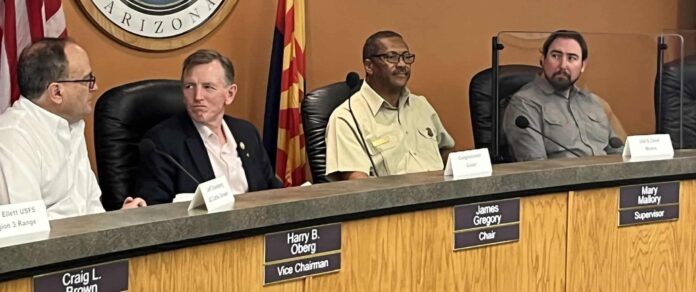This is the first part of a three-part story on the recent meeting of the Yavapai Cattle Growers’ Association.
Following the signing of a new memorandum of understanding between the Yavapai Cattle Growers’ Association, the U.S. Forest Service and several other parties, the group held a meeting hosted by the Yavapai County Board of Supervisors at the Yavapai County Administration Building in Cottonwood on Thursday, Sept. 7.
The two main subjects discussed were increasing livestock allotments for land leases within the Prescott National Forest, which had been reduced due to drought conditions that have since improved, and the effects of off-highway vehicles on rangelands on both the Prescott and Coconino National Forests.
“A key focus of what the collaboration was and what we are seeking has been to restock allotments that were dramatically cut in response to drought,” Jeff Eisenberg, a lobbyist for the Arizona Cattle Growers Association, told the audience. “The Prescott [National Forest] has made some efforts in restocking, [but] the view of the ranching community is more restocking activity needs to happen. But this MOU gives a proper framework for evaluating appropriate stocking rates.”
The MOU is a nonbinding agreement between the YCGA, the Arizona Cattle Growers’ Association, the Arizona Association of Conservation Districts, the University of Arizona Cooperative Extension and the Prescott National Forest, and with its signature by Prescott National Forest Supervisor Dale Deiter on Friday, July 19, took effect for five years.
“In June of 2021 … Deiter sent a letter out to all the permittees on the Prescott National Forest regarding the ongoing drought, and we were in the drought at that point,” event moderator and former YCGA President Andy Groseta said. “Requesting permittees to make some kind of adjustment of their ranching operations and asking them to get together with their range [conservationists] and District Rangers.”
Then, in “October 2021, the Forest Service came out with a Drought Management Decision Tool,” Groseta said. “That was a metric that they had put together, and it was created on the Prescott Forest … that was what started the whole exercise.”
Groseta referred to the Drought Management Decision Tool, which was eventually withdrawn, as “subjective” and “not peer-reviewed,” and added that it caused pushback from the cattle industry. The Forest Service subsequently cut stocking rates on grazing allotments by 45% in 2021 and 47% in 2022 based in part on application of that toolkit.
“It’s not just the [Drought Management Decision Tool]. There’s other tools that I’ve been involved in the field that to me wouldn’t pass the scrutiny of peer-reviewed, and they moved on and use those methods anyway,” University of Arizona range management specialist George Ruyle said.
“Some allotments are back to pre-drought levels and some are not. As I understand [it], [the] Forest Service is working through them as best they can,” Ruyle said.
There are currently 56 allotments within the Prescott National Forest, a number that will likely change as rangeland environmental planning “is completed to combine allotments,” National Forest Range Program Management Specialist Marc Stavropoulos said.
Twenty-four out of 36 full-year allotments within the forest are at or above the 22-year average for allowable cattle. Twenty additional winter and spring seasonal allotments are under review.
“Eleven of those allotments that aren’t at the 22 [year] average are due to numerous reasons such as ‘personal choice,’ ‘nonuse due to infrastructure needing repair,’ ‘reductions due to effects of drought and allotment not responding due to drought effects,’” Stavropoulos said.
In response to the Forest Service’s management, the YCGA formed a forest subcommittee last July that has met on a quarterly basis since then.
“We all know that the environmental organizations have been breathing down the back of the Forest Service and the [Bureau of Land Management] and the ranching community,” Groseta said. “We need that information and this is a good way moving forward where we can collect good scientific data.”
The last few years of discourse also resulted in the U of A Cooperative Extension adding 10 positions statewide that work with the cattle industry, which were funded by an $8 million appropriation from the Arizona State Legislature.
Ruyle said that while the agreement changes little about public lands management in Yavapai County, it is an important milestone to help formalize relationships between the parties involved.
The MOU called for the Prescott National Forest “to develop cooperative monitoring programs, allotment-specific monitoring plans and conduct on-the-ground monitoring, inventories and assessments” for the 58 active grazing allotments within the Prescott National Forest.
“[The MOU] provided a vehicle for county supervisors and others to get behind the programs, have monitoring programs on the Prescott [National Forest] and add additional funding,” Ruyle said.
To improve staffing levels in order to monitor the effects of grazing on Yavapai County public lands, the Board of Supervisors entered into a separate MOU with the Chino Winds National Resource Conservation District, which will provide $20,000 annually for the next five years to fund a full-time rangeland technician, who will be working throughout the Prescott National Forest.
“When we saw that the MOU was going to be more than likely signed, and we thought it had a high likelihood of success, our Board of Supervisors decided that we wanted to support that effort,” Yavapai County District 1 Supervisor Harry Oberg said during the meeting.
“Prescott National Forest did cut stocking levels during the drought, as they should have, and that seriously annoyed some ranchers,” Yavapai County Sierra Club Chairman Gary Beverly wrote in an email. “Now ranchers are trying to force stocking levels up again. You should understand that ranchers pay a ridiculously low fee for grazing public land — perhaps 10% to 20% of the going rate on the private market. The fees don’t cover management costs. Public lands grazing is a massive subsidy for ranchers.
“But the big question is, why is Yavapai County spending taxpayer money to further subsidize private business? This is what I don’t understand. Seems wrong to me. If a grocery store asked for a subsidy, the supervisors would laugh them out of the room.”
District 2 Supervisor and current Board Chairman James Gregory said that there was a general consensus among the meeting’s participants to increase the livestock allotments for Prescott National Forest permittees.
“Every dollar made by ranchers helps local businesses,” Gregory added, explaining what the county hopes to see in terms of return on its $100,000 investment. “They got to buy fuel [and] … and the economic impact is significant … I think that helps the overall county prosper.”



